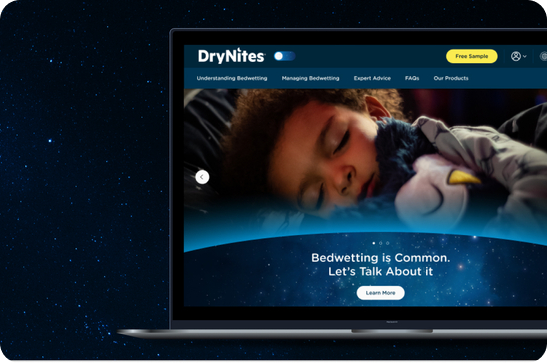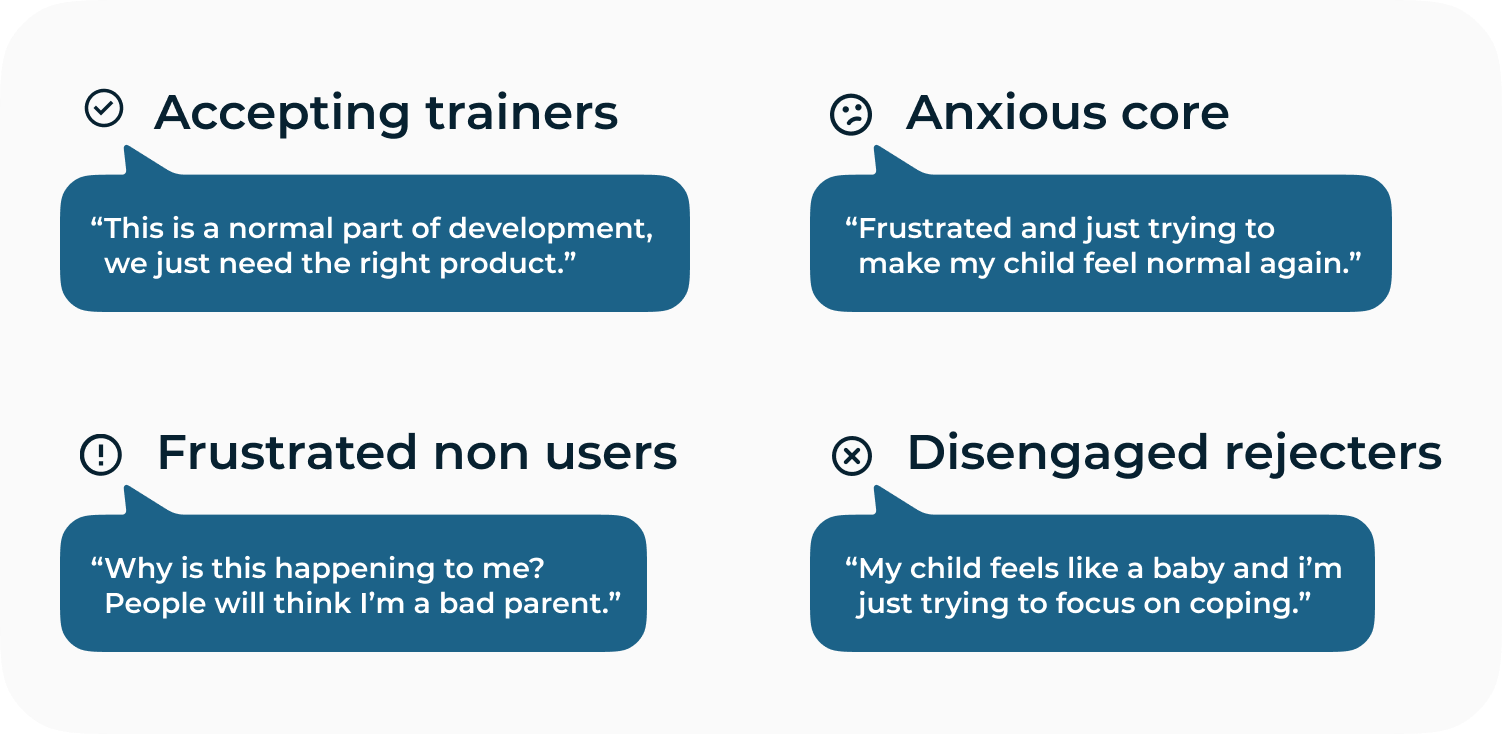-
We redesigned the DryNites UK and France sites while keeping in line with parent needs, concerns, and desires. Since the DryNites product deals with a somewhat taboo topic, it was crucial that each aspect of the site had empathy built at its core. We first focused our efforts on revamping the site architecture to ensure the sitemap, categories, and subcategories were intuitive.
In short, we successfully redesigned the UK and France sites while connecting with parents and comprehensively addressing bedwetting concerns. Our focus was to prioritize awareness and education while positioning DryNites as a credible source and the preferred bedwetting solution.
Guided by preliminary research, we first tackled information architecture challenges by organizing content for specific age groups and acknowledging the diverse needs and emotions of parents and children.
Our design journey consisted of the following steps: we built wireframes and high-fidelity prototypes and then used UserTesting.com to gather firsthand feedback from parents. This direct insight not only bolstered our design direction and reduced our time-to-market, but also garnered trust from stakeholders. While the project was being handed off to developers, we built the DryNites design system to have a single source of truth for designers and developers and to allow for a seamless experience if a designer needed to make a change in the future (making one change in the design system would instantaneously show up in the prototypes).
In conclusion, our empathetic and new design approach transformed the DryNites online experience, making it a more supportive and educational platform for parents and children facing the challenges of bedwetting.
Empathy at the core
DryNites is a Kimberly-Clark brand that offers disposable diapers and bedmats for managing enuresis (bedwetting). Our main goal to redesign the UK and France sites was to establish a stronger bond with parents, catering to their specific needs and concerns, all while rectifying the shortcomings of the previous site(s).
The main objective was not solely limited to product promotion. Instead, it encompassed a broader scope of addressing the concerns and needs of parents who might be up late at night confused and wondering if bedwetting is normal. The goal was to heighten awareness and education around bedwetting first, then promote DryNnites products as the preferred solution.
Below are some bedwetting statistics:
Rates of enuresis globally are from 8% to 20% between the ages of 3-15.
90% of them have primary nocturnal enuresis and have never been dry at night. The other 10% of children have been dry at night for at least 6 months but are now wetting the bed due to an external issue.
Up until age 12, bedwetting is about twice as common in boys as in girls, after which the gender difference tends to even out.
The average time children spend in the ‘youth pant’ category is 3.5 years which is greater than the time spent in a diaper as an infant.
Preliminary findings
Parents in search of information
DryNites.co.uk was a top product website parents went to to try and educate themselves on how to manage bedwetting.
Stakeholders looked to improve this metric and ensure the site was viewed as a respected and trusted site for information (note: DryNites worked with several doctors in the UK and France to write up-to-date articles on bedwetting as well as recommendations).
Time of day
An additional interesting finding was that parents in the UK, France, Belgium, and the Netherlands accessed the site mostly between the hours of 7 pm and 11 pm. This finding prompted us to first build the main redesign in Dark Mode—with a mobile-first strategy—which not only provided a more comfortable viewing experience but also aligned perfectly with the brand message since DryNites is a nighttime product.
Poor information architecture
DryNites sites across countries did not follow a consistent look and feel, and pages were inconsistent, unorganized, and did not have their audience in mind. The first large task of this redesign was to log all pages and reorganize them into more intuitive and easier-to-understand categories.
Four child and parent personas
Based on research, we identified four personas that parents and children fell into together: the 'Accepting Trainers', the 'Anxious Core', the 'Frustrated Non-User', and the 'Disengaged Rejecters'. These personas encompassed a wide spectrum of parent and child emotions, ranging from those who feel confident and understand that bedwetting is normal, to those who experience anxiety, frustration, or disconnection from the issue.
Recognizing these varied personas influenced our decision to also organize content based on age groups and ensure the content was ungendered. We understood that children facing bedwetting challenges at different ages would encounter individual issues. For example, sleepovers are a difficult trigger for parents and older children. This approach ensured that our resources and support articles were tailored to each age group, providing more effective guidance and empathy to parents and children alike.
A note about gender
Another finding was the unnecessary gendering of DryNites products—like associating blue and Marvel superheroes with boys and pink and Disney princesses with girls. To promote inclusivity, we recommended using the color blue for all products as they are night-time products. This change would empower children to choose based on their preferences, rather than gender, without confusion or shame. While the product hasn't changed yet, we are hopeful our recommendations will make a difference in the near future.
On to design and testing
We began by creating wireframes to ensure our website's structure and navigation were intuitive and worked the way we had envisioned. Then, we developed high-fidelity prototypes to share with stakeholders and for testing purposes. However, stakeholders sometimes had differing opinions on the designs due to personal preferences. To address this, we used UserTesting.com to gather feedback from our target audience within a day. This approach not only validated the design but also confirmed that users easily found the right information. Armed with positive results, we could continue building out pages for the site and complete the redesign.
All in all, we performed the following research with UserTesting.com:
Initial discovery and usability testing with 10 participants using
A/B tests for two different homepage designs with 10 participants
Another A/B test two additional layouts with 10 participants
A crucial discovery was how the platform allowed us to get verbatim feedback from parents currently addressing bedwetting, giving us valuable insights to share with stakeholders. Not only did we feel confident about our design and direction, but our stakeholders also loved hearing from customers and started trusting us more.
Design System
While building our design system template and reorganizing the Kimberly-Clark corporate system, we knew we would need to also build a DryNites design system. We took on this task while working with developers as they were starting to build the new site. We collaborated and encouraged them to leverage the design system for any detailed specs and guidelines and were open to their feedback as they were building. This partnership also gave us the confidence that the systems were working as intended.
Final thoughts
In short, we successfully redesigned the UK and France sites while connecting with parents and comprehensively addressing bedwetting concerns. Our focus was to prioritize awareness and education while positioning DryNites as a credible source and the preferred bedwetting solution.
Guided by preliminary research, we first tackled information architecture challenges by organizing content for specific age groups and acknowledging the diverse needs and emotions of parents and children.
Our design journey consisted of the following steps: we built wireframes and high-fidelity prototypes and then used UserTesting.com to gather firsthand feedback from parents. This direct insight not only bolstered our design direction and reduced our time-to-market, but also garnered trust from stakeholders. While the project was being handed off to developers, we built the DryNites design system to have a single source of truth for designers and developers and to allow for a seamless experience if a designer needed to make a change in the future (making one change in the design system would instantaneously show up in the prototypes).
In conclusion, our empathetic and new design approach transformed the DryNites online experience, making it a more supportive and educational platform for parents and children facing the challenges of bedwetting.





